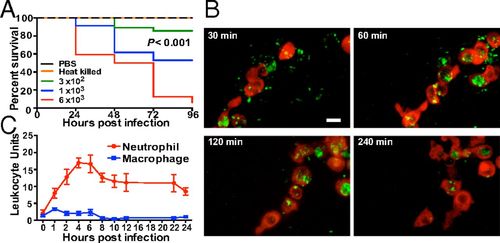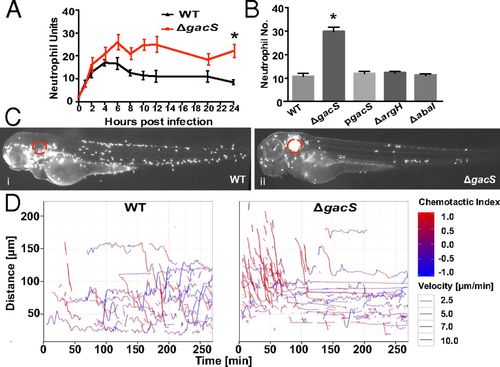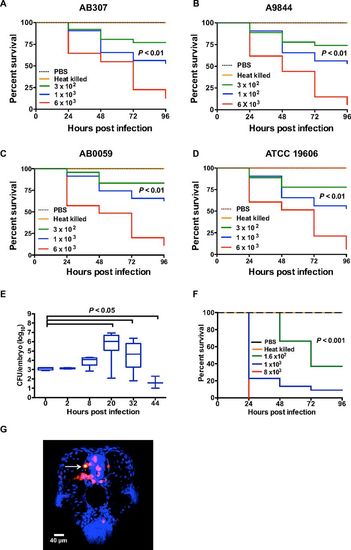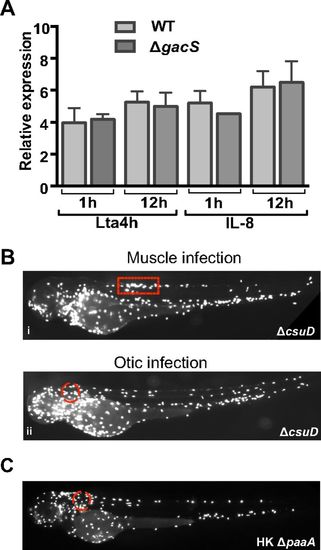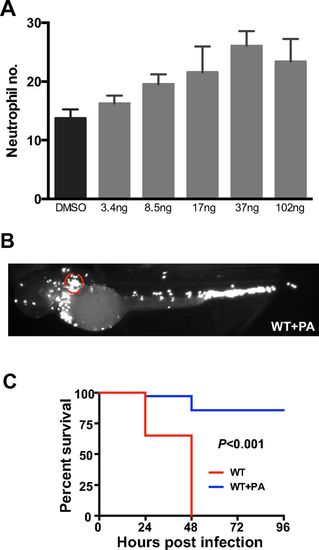- Title
-
Acinetobacter baumannii phenylacetic acid metabolism influences infection outcome through a direct effect on neutrophil chemotaxis
- Authors
- Bhuiyan, M.S., Ellett, F., Murray, G.L., Kostoulias, X., Cerqueira, G.M., Schulze, K.E., Mahamad Maifiah, M.H., Li, J., Creek, D.J., Lieschke, G.J., Peleg, A.Y.
- Source
- Full text @ Proc. Natl. Acad. Sci. USA
|
A. baumannii infection in zebrafish. (A) Survival after bloodstream infection with live A. baumannii (n = 30 embryos, three biological replicates; P value is a comparison of 3 × 102 and 1 × 103 cfu per embryo by log-rank test). (B) Time-lapse confocal scanning laser microscopy showing red neutrophils [Tg(lyz:DsRed)nz50] phagocytosing and clearing A. baumannii?GFP. (Scale bar: 20 µm.) (C) LUs after infection into the somatic muscle of zebrafish after adjustment for trauma (PBS solution injection; mean ± SEM, n = 5 per experiment, three biological replicates). |
|
Neutrophils are indispensible for zebrafish survival from A. baumannii infection. (A) Phagocytosed A. baumannii (pHrodo-dextran stain, white arrow) is handled within acidic phagolysosomes within a neutrophilic vacuole at 50-min postinfection [Tg(mpx:GFP)il14 embryos with green fluorescent neutrophils were used]. (Scale bar: 20 µm.) Survival of neutrophil-depleted embryos (csf3r MO) (B) or macrophage-depleted embryos (irf8 MO) (C) after bloodstream infection with A. baumannii. Comparison is made vs. A. baumannii-infected embryos injected with control morpholino (Ctrl MO; P < 0.001; n = 30 embryos, three biological replicates). EXPRESSION / LABELING:
|
|
Altered in vivo neutrophil migratory patterns during A. baumannii infection. (A) Localized somatic muscle infection with A. baumannii ΔgacS led to greater neutrophil units at the site of infection and a loss of migration away compared with wild-type A. baumannii infection (mean ± SEM from three biological replicates). (B) Neutrophil units at the site of a localized somatic muscle infection 48 hpi showed restoration of neutrophil numbers with gacS complementation (pgacS) and no abnormalities with other A. baumannii virulence-associated mutants (ΔargH, ΔabaI; mean ± SEM, three biological replicates). (C) Infection of the otic vesicle (red circle) with wild-type A. baumannii (i) and ΔgacS (ii) imaged at 48 hpi. (Magnification: 10×.) (D) Cell tracking analysis of neutrophil movement after infection with WT and ΔgacS strains. A chemotactic index (red, movement toward infection; blue, movement away) and velocity (thickness of the line) are indicated (representative experiment from five biological replicates). Asterisks in A and B denote comparison between wild-type A. baumannii and ΔgacS (*P ≤ 0.05). |
|
PA is a bacterial-driven chemoattractant. (A) Neutrophil accumulation imaged 48 hpi of the otic vesicle (red circle). (B) The observed neutrophil clustering was associated with a reduction in neutrophils normally resident in the caudal hematopoietic tissue assessed at 48 h. The functional effect of this neutrophilic response to A. baumannii ΔpaaA infection was a reduced bacterial burden (C) and increased zebrafish survival (D) compared with wild-type A. baumannii and the complemented strain (ppaaA; P value is a comparison of ΔpaaA and ppaaA by log-rank test). (E) Attraction of neutrophils to the otic vesicle 6 hpi of culture filtrate. (F) Concentration of PA in culture filtrates. (G) Injection of purified PA into the otic vesicle was sufficient to attract a greater number of neutrophils within 2 h of injection compared with PBS solution. (H) Neutrophil chemotaxis toward PA (0.05 M) in an ex vivo neutrophil transwell migration assay using mouse-derived neutrophils. fMLP was used as a positive control. For all experiments, column bars represent the mean ± SEM, performed at least in triplicate, and the asterisks denote comparison between wild-type A. baumannii and ΔpaaA for B, C, and F, between LB and wild-type, ΔpaaA, and ppaaA for E, and between PA and PBS control for G and H; letter Φ denotes comparison between wild-type and ΔpaaA for E by one-way ANOVA (Kruskal?Wallis test, *P ≤ 0.05, **P < 0.01, and ΦP ≤ 0.05). (Magnification: 10×.) |
|
Zebrafish survival after bloodstream infection with clinical A. baumannii strains: (A) AB307, (B) A9844, (C) AB0059, and (D) ATCC 19606 (n = 30 embryos, three biological replicates; P value is a comparison of 3 × 102 and 1 × 102 cfu per embryo by log-rank test). (E) Bacterial density over time in zebrafish. At a lower infection inoculum, zebrafish were able to control and clear infection [median (range) of five homogenized embryos at each time point, pooled data from four biological replicates and compared using unpaired t test with Welch?s correction]. (F) When zebrafish were infected into the yolk sac, hypersusceptibility to lethal infection was observed (n = 30 embryos, three biological replicates; P value is a comparison of 1.6 × 102 and 1 × 103 cfu per embryo by log-rank test). (G) Histopathological section taken at 2 h through a localized somatic muscle infection with A. baumannii-GFP. Neutrophils are red fluorescent [Tg(lyz:DsRed)nz50] with DAP counterstain (white arrow indicates phagocytosed bacteria). (Scale bar: 40 µm.) |
|
(A) After phagocytosis, A. baumannii is handled within acidic phagolysosomes as shown by the red fluorescence (pHrodo-dextran stain) within a neutrophilic vacuole (white arrow) at 50 min postinfection [Tg(mpx:GFP)il14 embryos with green fluorescent neutrophils were used]. In each panel, the maximum-projection z-stack image (i) is supplemented by x (ii) and y projections (iii). (B) Whole-embryo neutrophil numbers were counted using ImageJ at 48 hpf. Neutrophil numbers were decreased in csf3r MO-injected embryos and increased in irf8 MO-injected embryos (n = 15 per group pooled from three independent experiments; error bars represent mean ± SD). (C) Whole-embryo macrophage numbers were counted by using ImageJ at 48 hpf. Macrophage numbers were decreased in irf8 MO-injected embryos and were unchanged in csf3r MO-injected embryos. Asterisks represent comparison between control MO and csf3r MO or irf8 MO (n = 15 per group pooled from three independent experiments; error bars represent mean ± SD; *P ≤ 0.05 and **P < 0.01, one-way ANOVA, Kruskal-Wallis test). (D) Zebrafish infected with the Acinetobacter quorum-sensing mutant (ΔabaI) showed greater survival compared with wild-type Acinetobacter (M2 strain) and the complemented strain (pabaI) in zebrafish (P value is a comparison of M2 and ΔabaI) and (E) a murine septicemia model (n = 15 per group; P value is a comparison of M2 and ΔabaI by log-rank test). |
|
(A) Localized somatic muscle infection (red rectangle) imaged at 48 hpi with wild-type A. baumannii (ATCC 17978) (i), ΔgacS (ii), and the complemented strain (pgacS) (iii). (B) Infection into the otic vesicle (red circle) with A. baumannii ΔargH and ΔabaI at 48 hpi showing no evidence of neutrophil clustering. (C) Cell-tracking analysis of neutrophil movement after infection with WT and ΔgacS strains. A chemotactic index (red, movement toward infection; blue, movement away) and velocity (thickness of the line) are indicated (representative experiment from five biological replicates). This image is an enlarged version of Fig. 4D for a clearer view of the cell-tracking analysis. (Magnification: 10×.) |
|
(A) Relative gene expression of IL-8 and Lta4H in wild-type A. baumannii (ATCC 17978) and ΔgacS-infected zebrafish embryos at 1 and 12 hpi. Compared with uninfected embryos, mRNA for IL-8 and Lta4H was increased, but there was no significant difference between wild-type A. baumannii and ΔgacS-infected embryos. Experiments were performed at least in triplicate with three biological replicates (mean ± SEM). (B) Neutrophil clustering was not seen for an A. baumannii mutant involving another GacS-regulated gene (csuD) in a somatic muscle (red rectangle) (i) or otic vesicle (red circle) (ii) infection at 48 hpi. (C) Neutrophil chemotaxis was seen, but dwelling was not observed for heat-killed A. baumannii ΔpaaA (HK ΔpaaA) infection at 48 hpi. (Magnification: B and C, 10×.) |
|
(A) Neutrophil chemotactic response to varying concentrations of purified PA injected into the zebrafish otic vesicle and quantified at 6 hpi. (B) The addition of PA (37 ng) to culture filtrate from wild-type A. baumannii was sufficient to elicit a neutrophil clustering response after injection into the otic vesicle (red circle) at 48 hpi. (Magnification: 10×.) (C) Survival after bloodstream infection with live wild-type A. baumannii mixed with PA led to greater survival of embryos compared with infection with wild-type A. baumannii alone (n = 30 embryos, three biological replicates; P < 0.001, log-rank test). |

